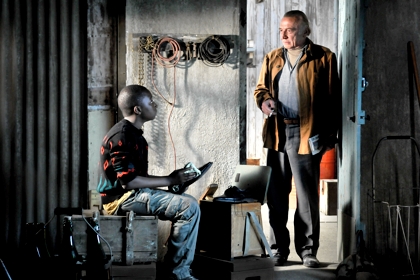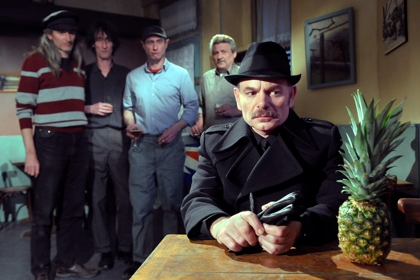Primary navigation


In Aki Kaurismäki’s deadpan fairytale of working-class solidarity, quirky flirts with cutesy and bathos with true poignancy. Hannah McGill sees the raw humanity shining through
With their stagey compositions, mannered gestures and paintbox hues, Aki Kaurismäki’s films have a storybookish quality that’s comforting even when his characters find themselves in direst strife. The backbone of Le Havre is a tale of cooperation in the service of a virtuous goal so elemental that it could be a children’s fable, or a socially conscious silent film from Charlie Chaplin’s oeuvre: a community joins forces to aid a beleaguered innocent, and is rewarded with triumph. A sequence in which African child refugee Idrissa (Blondin Miguel) is transported to Le Havre’s docks in a vegetable barrow is cartoon-cute; elsewhere, the near-death of the protagonist’s wife is depicted in a deadpan-dramatic mode that references 1950s melodrama (and resonates with Kaurismäki’s fondness for classical, studio-style lighting and 1950s decor and furnishings).
The danger with such self-aware presentation is that quirky gives way to cutesy, and faux-naiveté to the real thing. But with this 17th feature film – his second entirely in French, and a follow-up of sorts to the previous one, 1992’s La Vie de Bohème – Kaurismäki displays a sustained grace in negotiating the boundary between bathos and true poignancy. Indeed, the management of boundaries – national ones, legal ones, personal ones – is the recurrent theme of Le Havre; its thoughtfully evoked political context and subtle moral ambiguity lend it texture and depth. Its universe is further bulked out by its references to Kaurismäki’s previous films, and to his beloved French New Wave, symbolised by the brief appearance of Jean-Pierre Léaud as a police informer.
Marcel Marx (André Wilms), seen as a struggling playwright in La Vie de Bohème, is now living with his loving wife Arletty (Kati Outinen) in the port town of Le Havre, and scraping a living shining shoes. Instinctive goodness and a residual resistance to authority drive him to endanger himself by aiding Idrissa. That Idrissa, along with the other Africans Marcel encounters, is portrayed as faultlessly cultured, kind and polite risks pitching the film into a sort of post-ironic fairytale idealism, as does Arletty’s miraculous recovery from (presumably) cancer.
But Kaurismäki finds shades of grey elsewhere, in his evocation of working-class and immigrant communities adrift from conventional power structures and sustained by cynicism, canniness and tribal loyalty. Authority is faceless and disconnected – the chief of police, advocating the pursuit and entrapment of Idrissa, appears as a voice only – and Christian doctrine an unreliable guide. Assured by her doctor that “miracles happen”, the ailing Arletty retorts, “Not in my neighbourhood.” Superstition is a luxury those at her economic level can ill afford. Nor is prelapsarian sinlessness a desirable state: told by Inspector Monet (Jean-Pierre Darroussin) that he’s “not innocent”, Marcel rejoins with pride, “And I never have been.”

‘Bohemian’ values – cooperation, creativity, ethical flexibility, sexual freedom – are not only evoked in names (Marx, Arletty, Monet) but emerge as constant challenges to bourgeois expectations. In the end it is always deception, not truth, that sets these characters free. Their most courageous moments entail deliberate falsehoods: Marcel and Inspector Monet both lie to protect Idrissa; Arletty opts to protect the husband she calls “a big child” from the knowledge that she is dying. Romantic love represents a stronger call to action than any moral imperative. If Marcel doesn’t quite undertake his mission to save Idrissa as a deal with God to earn Arletty’s survival, he certainly uses it as a distraction to get through her troubling absence; and the pivotal assistance of local celeb ‘Little Bob’ (Roberto Piazza) in the plan proves dependent upon the solution of a calamitous marital dispute.
Thus, for all its visual stylisation and mordant jokiness, Le Havre is brought to life by its raw, hopeful humanity; it feels close and real despite its deliberate distance. Still, whether the film’s almost shockingly wish-fulfilling conclusion unbalances it with too much deadpan schmaltz, comments drily on cinema’s compulsion to play God by punishing and rewarding characters’ deeds, or simply confounds cynicism by allowing the best to happen, is a point for post-show discussion.
Subterranean homesick blues: Nick James on Dirty Pretty Things (November 2002)
Aki Kaurismäki’s top ten films ever made (September 2002)
What Time Is It There? reviewed by Tony Rayns (July 2002)
Code Unknown reviewed by Richard Falcon (May 2001)
The cruel seaside: Iain Sinclair on Last Resort (March 2001)
À la Place du coeur reviewed by Elisabeth Merriman (October 1999)